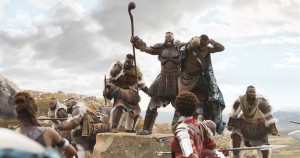I’ve watched the “Black Panther” teaser trailer close to 30 times.
When the trailer was released last summer, everything about it captivated me – from the fast-paced editing which is in time with the music to the vibrant production design that lit up the screen. But what captured my attention most was the breathtaking number of people of color on screen, all portrayed with dignity and power.
If the early reviews for the upcoming film are any indicator, “Black Panther” will be a game changer for superhero movies and representation in film. But the film also makes a strong case for diversity behind the camera as well. “Black Panther” is a testament to the idea that, while it is important to tell the stories of people of color, it is of equal importance that Hollywood let people of color tell those stories.
That is not to say that white directors should avoid telling stories about people of color – it is absolutely possible to tell a story about people of another race or culture, even if it does mean walking a thin line between cultural appreciation and appropriation. However, as “Black Panther” demonstrates in its story and costume design, there is a certain power in handing the reins over to people of color that results in a spectacular movie.
The best example lies in the film’s handling of the character M’Baku, based on a character who had the same name in the comics. In the comics, M’Baku was a supervillain known as Man-Ape, and donned a white gorilla-fur costume. Somehow, someone in 1969 thought that was a good idea.
The characterization of M’Baku as a gorilla is deeply problematic, since racists have historically compared black men to gorillas, which director Ryan Coogler highlighted.
“Having a black character dress up as an ape, I think there’s a lot of racial implications that don’t sit well, if done wrong,” he said.
However, since M’Baku was also one of Black Panther’s frequent enemies – one might call him the Venom to Black Panther’s Spider-Man – he is inherently wrapped up in the legacy of the comics while standing counter to the progress and empowerment that Black Panther represents.

In another director’s hands, M’Baku might have been cut out altogether, left as a racist caricature relegated to history. Or worse, he might have been included in the movie while maintaining his “Man-Ape” moniker; it’s unfortunately not difficult to imagine a nonblack director who could overlook the racist undertones that the character holds.
Coogler, however, opted for a different approach.
Instead of avoiding M’Baku, Coogler chose to include him and stripped him of his offensive title. In the film, Winston Duke plays a completely revised version of M’Baku, who is now the head of the tribe that has religious reverence for the gorilla and considers it sacred. Coogler’s creative reworking is powerful, because it not only pays homage to the original character and the comics, but also reclaims him.
The decision required razor-sharp precision, but when it was announced, it set the tone for what audiences could expect: a culturally sensitive and powerful film. It was clear that Coogler is someone who has the dexterity to navigate the tightrope between offensive and empowering – a testament to both his skills as a director and his experiences as a black man.
It might seem obvious that research and thought should go into a film’s production, but there are countless examples of times when filmmakers simply didn’t do their homework. The result is a portrayal of marginalized communities in an insincere and cliched way such as with the Amazonian battle gear in “Justice League.” In the film’s predecessor, “Wonder Woman,” the Amazons donned beautiful-yet-functional outfits modeled after ancient Roman and Greek armor and were designed by Lindy Hemming. However, when the Amazons reappeared in “Justice League,” with new costumes designed by Michael Wilkinson, welded metal breastplates were replaced by what seemed to be leather sports bras. I’m not an expert on proper battle wear, but I certainly know which look I’d choose.
“Black Panther” avoided any potential problems with generic or stereotypical costumes through intensive research by Ruth E. Carter, the film’s costume designer and an African-American woman. For her designs, Carter pulled from cultures throughout Africa – for example, she based the Vibranium jewelry of the Dora Milaje, a female fighting force, on the neck rings of the Ndebele women, which are worn to represent wealth and status. Angela Bassett’s queen-mother character also dons a 3-D printed headpiece modeled after Zulu hats. The designs are incredible because they find ways to incorporate real African design elements intentionally, rather than just creating something colorful, yet generic – Carter created a cultural fashion for a fictional country that still felt authentic.
People of color don’t have a monopoly on being culturally sensitive or doing thorough research. But time and time again in Hollywood, decisions made by white executives have been incorrect, leading to the creation of insensitive or exploitative works.
While their mistakes don’t mean white people should be barred from film, they certainly make a strong case for supporting voices and visions of color – in the best way possible.
